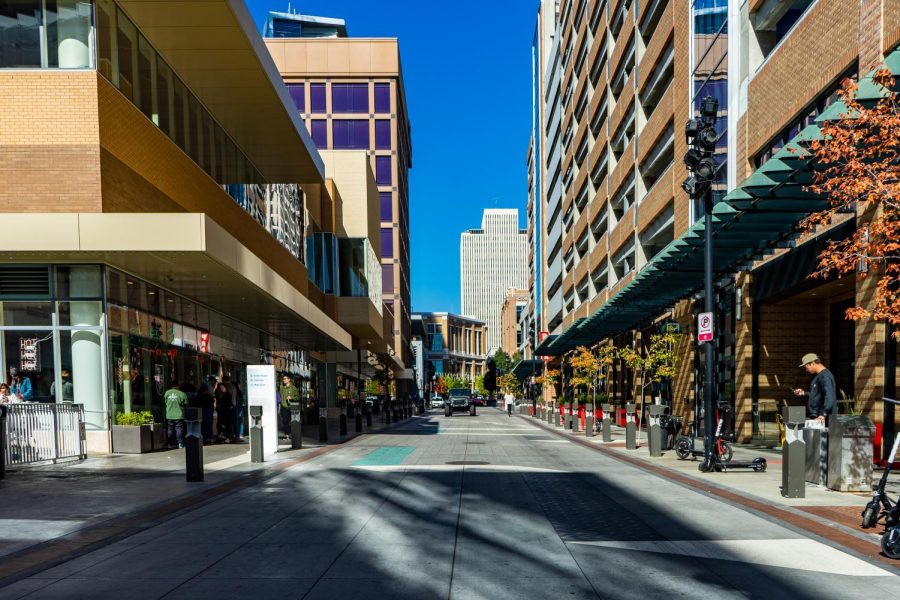Mismash: Rent Control Is A Short-Term Solution
Downtown Salt Lake City. Opinion writer Sarah Mishmash says that even with high housing prices in Salt Lake, rent control is a “temporary fix that would eventually land us in a worse place than we started.” | Chronicle archives
February 11, 2020
Utah State Representative Jennifer Dailey-Provost is sponsoring a bill that removes restrictions and allows Utah towns, cities and counties to promote rent controls. Previously, towns, cities and counties could only impose such restrictions with the express permission of the legislature. To be perfectly clear, Dailey-Provost’s bill doesn’t itself impose rent control, but it clears the way for cities to start. The bill has been introduced with good intentions, I’m sure – Utah is a bit of a mess in terms of affordable housing, especially here in Salt Lake. But this is not the solution we need. Allowing rent control in Utah will only make the housing situation worse.
At first thought, Dailey-Provost’s bill seems like it would keep housing costs affordable for low-income residents and prevent landlords from unexpectedly jacking up prices — both great goals, in my mind. After six months of living in southeastern Arizona, where my rent was well under $600 a month, I wasn’t pleased to discover that the average rent in Salt Lake is just about twice that. Even as I first discussed this legislation with my husband, we both agreed that it would be pretty nice to have a cap on rent. But upon further research, the general consensus is that rent control does more harm than good.
Rent control doesn’t address the underlying causes of financial struggle — it jumps straight to attacking the symptoms. It ignores that one of the main issues behind skyrocketing housing costs is more demand than supply. Rent control then tends to make the situation worse by making property management less profitable. Developers have less incentive to build more units, and landlords may find that existing units cost too much to maintain. This motivates them to convert units into higher value condos, taking even more rental units from the market.
Cities also typically don’t impose rent control on all rental units because they understand, at least to some extent, that it discourages people from supplying more of it. When cities control just some of the rental units, they create a two-tier rental market. Instead of addressing the real problem, these policies divide housing into rent-controlled apartments — which rarely turn over tenants, because they know they won’t get a better price anywhere in the city — and market-value apartments — whose prices just keep rising as the population keeps growing and the housing options stay the same.
But would rent control help those in Utah who need it the most? Probably not. Remember those rent-controlled apartments that keep the same tenants for years? They don’t always (or even usually) go to people who need the cheapest rent. In fact, when Los Angeles did a study of how their rent control ordinances were working (in 1988, because that’s how outdated this idea is) they found that the main beneficiaries of such controls were white, in a household of two or less and generally making over $40,000 a year. Meanwhile, rent went up for people making less than $10,000 a year, as well as for minority groups. (More recent studies have also confirmed the negative effects of rent control.)
The primary beneficiaries of rent control aren’t families or people with the lowest income in the city. When demand is high, landlords have their pick of tenants and are more likely to approve applications for the people who can pay. This leaves those who need rent control the most in market-value apartments with rising costs due to rent control.
One solution to elevated housing costs is to simply build more housing. As more apartments are built, more people will move in and fewer will be left competing for a few affordable places. As a result, prices will start to lower. But the reality is we live in Utah, and there’s only so much land to go around. Sure, zoning laws could make it easier to add mother-in-law apartments in neighborhoods with single-family homes. The legislature could introduce tax incentives for companies to build more housing units, and land-use regulations could be eased to make room available to build on. There isn’t any one solution that will fix everything, but rent control is a step in the wrong direction.
Dailey-Provost’s bill won’t single-handedly secure rent control ordinances in every Utah city. Even if it passes, there’s room for cities and counties to decide that they don’t want these policies. Still, it’s better for the state as a whole if we leave rent control out of the equation. It would be a temporary fix that would eventually land us in a worse place than we started. We should pursue other ideas and opportunities to help fix the cost of living in Utah.








